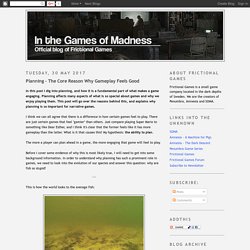

Tommy Thompson's Blog - Building the AI of F.E.A.R. with Goal Oriented Action Planning. 'AI and Games' is a crowdfunded YouTube series that explores research and applications of artificial intelligence in video games.

You can support this work by visiting my Patreon page. The AI of F.E.A.R. is a well-worn subject and one that I have already covered on the 'AI and Games' YouTube channel, in fact it was the very first episode back in 2014! But in keeping with the channel breaking 100,000 subscribers, I decided to return to the the topic and deliver it again in richer detail as part of my sub-series AI 101. The video game industry has strived to find accessible and pragmatic approaches for non-player characters (NPCs) to make intelligent decisions quickly and effectively.
This has led to innovations ranging from navigation meshes for helping a character move around a 3D environment to Finite State Machines in games such as Half Life for character behaviour. Automated Planning For example, consider a closed Door we label as ‘Door1’. Goal Oriented Action Planning Closing. : Sergio Ocio Barriales's Blog - You had me at 'AAAAHHH' – On the Importance of Reactions in Game AI.
The following blog post, unless otherwise noted, was written by a member of Gamasutra’s community.

The thoughts and opinions expressed are those of the writer and not Gamasutra or its parent company. Reactions are an important aspect of an AI’s performance, and getting them right is fundamental to any modern AAA game AI system. This post is NOT about decision-making, it is about good reaction design regardless of the decision-making approach. How should our NPCs react to different stimuli? I will talk about our objectives when working on AI reactions, and how these can contribute to building good game AI. Disclaimer: there is a wide array of video game experiences, and each presents different challenges. Artificial Intelligence – it is everywhere. In a video game, our number one goal is to create a fun and rich experience.
When an agent perceives a stimulus, this information goes to some decision-making system, choosing whether to ignore the event or handle it. Voice Repetition. OpenAI experiment proves that even bots cheat at hide-and-seek. Emergent Tool Use from Multi-Agent Interaction. Paper Environment Generation Worldgen In our environment, agents play a team-based hide-and-seek game.

Hiders (blue) are tasked with avoiding line-of-sight from the seekers (red), and seekers are tasked with keeping vision of the hiders. There are objects scattered throughout the environment that hiders and seekers can grab and lock in place, as well as randomly generated immovable rooms and walls that agents must learn to navigate. There are no explicit incentives for agents to interact with objects in the environment; the only supervision given is through the hide-and-seek objective.
How A Plague Tale: Innocence’s rat hordes were made. Taking Back What's Ours: The AI of Dishonored 2. Game Mechanic Explorer. Defining Gameplay: Between structure and chaos. How Cameras in Side-Scrollers Work. In The Games Of Madness: Planning - The Core Reason Why Gameplay Feels Good. In this post I dig into planning, and how it is a fundamental part of what makes a game engaging.

Planning affects many aspects of what is so special about games and why we enjoy playing them. This post will go over the reasons behind this, and explains why planning is so important for narrative games. I think we can all agree that there is a difference in how certain games feel to play. There are just certain games that feel "gamier" than others. Just compare playing Super Mario to something like Dear Esther, and I think it's clear that the former feels like it has more gameplay than the latter. The more a player can plan ahead in a game, the more engaging that game will feel to play. Before I cover some evidence of why this is most likely true, I will need to get into some background information. This is how the world looks to the average fish: They can really only see 1-2 meters in front of them and often it's even worse than that.